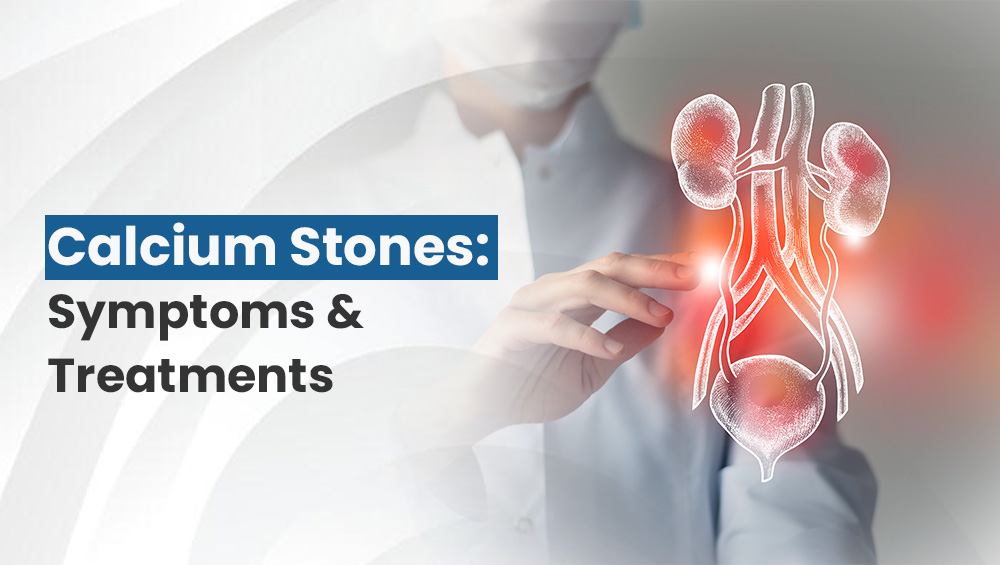Among all types of kidney stones, calcium stones are the most common and painful subtype that can interfere with everyday life, causing severe sharp pain in the lower back, hematuria and frequent urination. These stones develop due to excessive calcium levels mixing with other substances, such as oxalate or phosphate, in the kidneys.
This uncertainty over when the next episode might happen is very difficult to live with, affecting work, sleep and social activities. In addition to pain, calcium stones that reoccur subsequently indicate that there are underlying health issues of dehydration, dietary imbalances or metabolic disorders which have not been adequately addressed.
The upside is these calcium stones are treatable and preventable if you approach them correctly. These can be made through lifestyle changes and dietary management or very advanced methods, like shock wave lithotripsy or minimally invasive surgical techniques. You can take charge and manage symptoms by with a treatment and prevention plan tailored for you while also helping reduce the risk of future stones so that your quality of life stays high.
How are calcium stones formed?
When there is too much calcium in the urine that binds with oxalate or phosphate, calcium stones are formed. This occurs when the urine is highly concentrated with these minerals, and as they start to bond, crystallize. Eventually, these crystals become larger and develop into hard deposits, or stones, in the kidneys.
Several potential causes of calcium stones range from dehydration, diet, heredity and medical conditions. For example dehydration may result in more concentrated urine facilitating calcium and oxalate crystal formation.
An oxalate–rich diet (including such foods as spinach, nuts, and chocolate) or excess calcium intake without compensating bisa also increase the risk of stone formation. Conditions that raise calcium in the blood and urine, such as hyperparathyroidism or kidney diseases, also add to this risk.
Knowing this may help you with lifestyle changes and prevention strategies to prevent calcium stones, protect your kidneys and avoid the pain from stones.
what are the symptoms if you have Calcium Stones?
If you have calcium stones, symptoms can range from mild to severe and may vary depending on the stone’s size, location, and whether it’s causing a blockage. Here are the most common symptoms:
- Sharp, Intense Pain: One of the hallmark symptoms of kidney stones is sharp, severe pain in the back, side, or lower abdomen. This pain can come and go and often radiates to the groin area as the stone moves through the urinary tract. The intensity can be debilitating and may require urgent medical attention.
- Blood in the Urine (Hematuria): When calcium stones move or rub against the walls of the urinary tract, they can cause small tears, leading to blood in the urine. This might appear as pink, red, or brown discoloration, depending on the severity.
- Frequent Urges to Urinate: If a stone is moving closer to the bladder, it can create a persistent feeling of needing to urinate, even if little urine is released each time. This symptom can resemble a urinary tract infection (UTI).
- Painful Urination: As the stone moves into the bladder or the ureter, it can cause a burning sensation during urination, similar to the symptoms of a UTI.
- Nausea and Vomiting: The intense pain associated with kidney stones often triggers nausea or vomiting, as the body reacts to the severe discomfort.
- Cloudy or Foul-Smelling Urine: If the stone causes a blockage, it can lead to infection, resulting in cloudy or unusually odorous urine.
- Fever and Chills: If a stone leads to a urinary tract infection, fever and chills may accompany the other symptoms. This is a sign that medical attention is needed promptly to prevent complications.
If you experience these symptoms, especially if they’re severe or persistent, it’s essential to consult a healthcare provider. Early diagnosis and treatment can help manage pain, clear the stones, and prevent future occurrences.
what are the treatment options for Calcium Stones?
Treatment options for calcium stones vary depending on their size, location, and the severity of symptoms. Here’s a breakdown of common treatments:
Calcium stones can be treated differently based on their sizes and place along with the symptoms. Here’s a summary of the most popular treatments:
1. Retrograde Intrarenal Surgery (RIRS)
Retrograde Intrarenal Surgery (RIRS) is a highly sophisticated mind-wresting method of inoperable, painless and complex treatment to disintegrate kidney stones primarily located inside the body called ‘intratracheally or when they are situated at hard-to-reach areas. RIRS involves the passing of a flexible ureteroscope through the urethra, to bladder and up into kidney, where the surgeon has direct visualization and access to the stone.
This method uses laser to fragment the stone into small pieces, that can then be extracted with special instruments or they will pass naturally in the urinary tract. RIRS is indicated for stones that are too big to pass, but too small to warrant open surgery
2. External Shock Wave Lithotripsy (ESWL):
External shock wave lithotripsy (ESWL) utilizes noninvasive shock waves to fragment larger stones into smaller pieces, which pass more easily on their own through the urinary tract. The procedure is a non-invasive procedure for stones that are hard to pass but do not require surgery.
3. Ureteroscopy:
If the stone is stuck in the ureter, a specialist may suggest a procedure called ureteroscopy — a minimally invasive surgery where a thin scope is inserted through the urinary tract to get to and remove or break up the stone. Particularly if a stone causes an obstruction, ureteroscopy can quickly relieve it.
4. PCNL (Percutaneous Nephrolithotomy):
For larger or more complicated stones, PCNL may be advised. In this minimally invasive procedure, the doctor will insert a tool through a small cut in your back to access the kidney and take out the stone. In cases where ESWL or a ureteroscopy cannot be performed (because of stones that are too large or irregularly shaped), PCNL can be used.
The patient condition, size and type of stone, and general health determine the suitable treatment option for the patient. A specialist consultation guarantees the best alternative to calcium stones treatment and prevention.
Your Trusted Kidney Health Care – CureStone
So, all this into consideration, CureStone is at your service as a trusted kidney health partner, offering expert care and personalized treatments to manage and prevent kidney stones. From advanced diagnostics to minimally invasive procedures like RIRS and comprehensive post-treatment support, our focus is on enhancing your well-being and restoring your quality of life. Trust CureStone for effective, compassionate and personalized solutions at every step of your kidney health journey.

